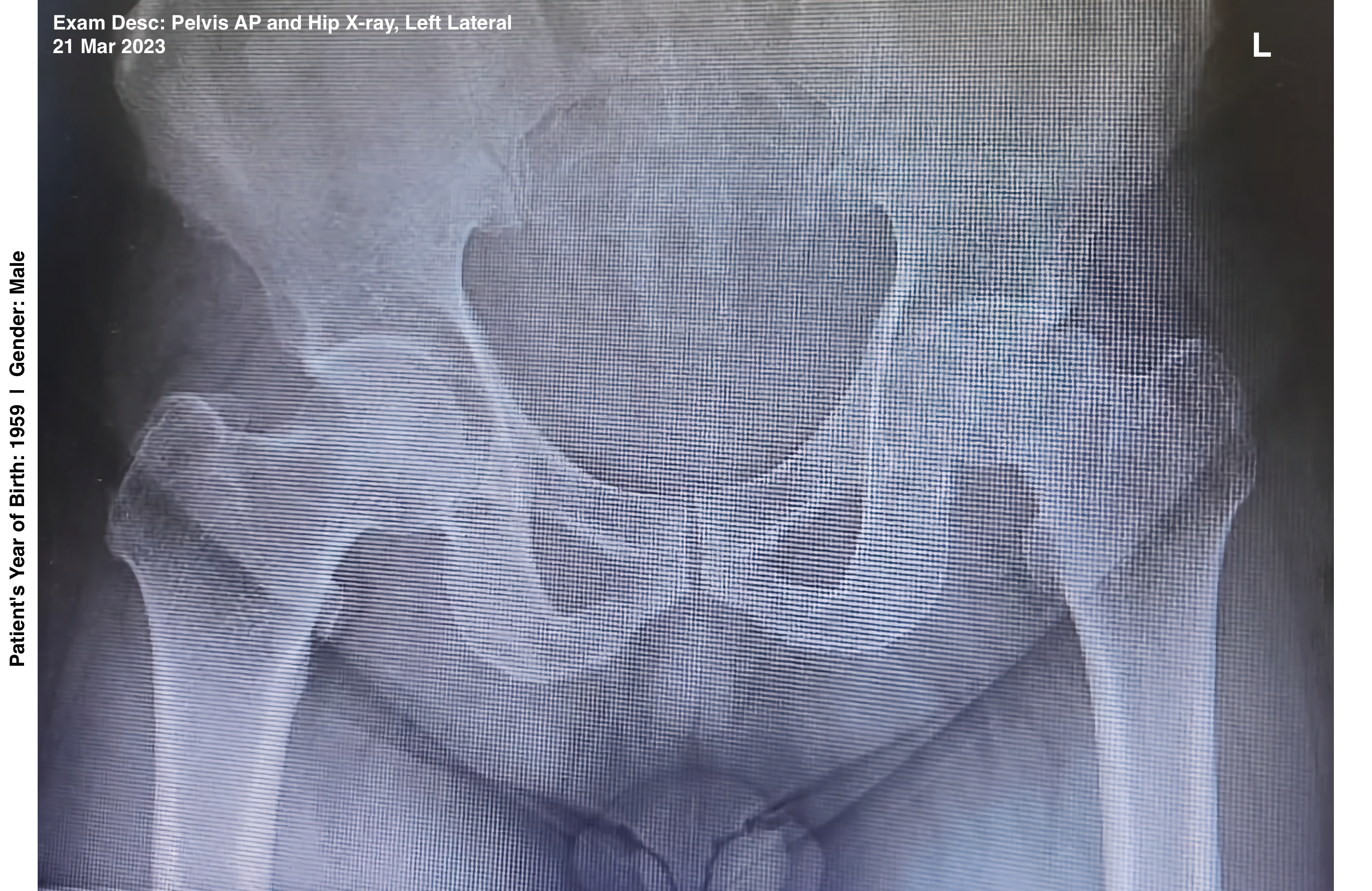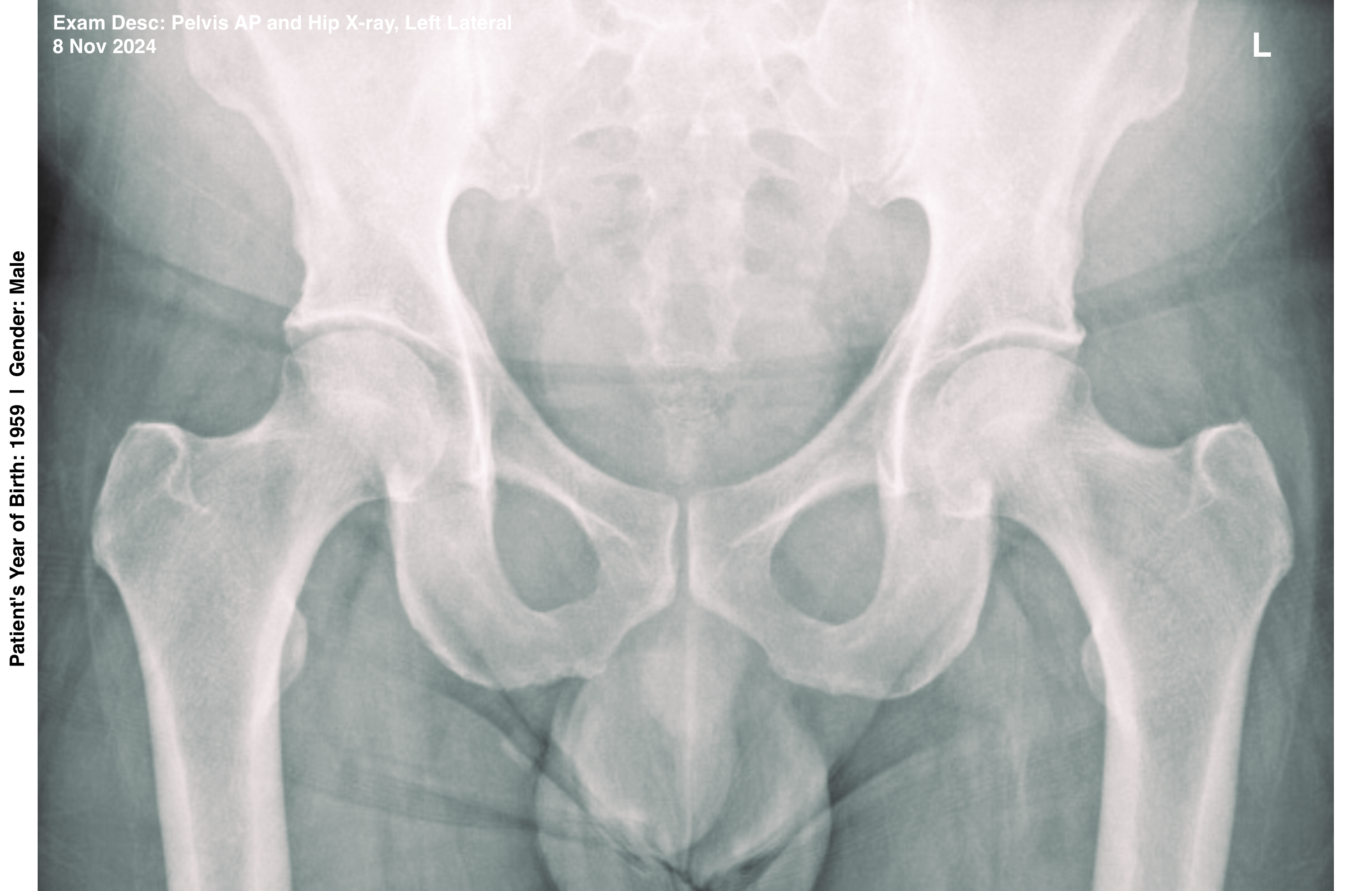HEAL-HIP-CS01-65M-202203
Complete Functional Recovery in Advanced Hip Degenerative Arthropathy Without Surgery Following the HEAL Method™: A Case Report
Published/Copyright: 10 August 2025
Abstract:
Background: Advanced degenerative hip arthropathy is typically managed surgically once conservative therapy fails. Recovery to full function without surgical intervention is rarely documented.
Case Presentation: A 65-year-old Asian male presented with progressive lower back and left hip pain beginning in early 2019. MRI in March 2022 revealed lesions involving L3–S1 vertebral levels. Despite a structured rehabilitation program, symptoms worsened, leading to functional limitations and reliance on potent analgesics. Radiographs in March 2023 demonstrated advanced degenerative changes of the left hip joint, and a superimposed acute fracture of the left femoral head. Total hip arthroplasty was advised but declined.
Intervention: In June 2024, the patient underwent six sessions of the HEAL Method™—a non-invasive, multimodal mind–body treatment incorporating biomechanical correction, targeted soft-tissue release, and neuromuscular re-education.
Outcome: Post-intervention, the patient reported complete symptom resolution, discontinued analgesics, and regained full hip function. Follow-up imaging in November 2024 revealed normalization of joint space, restoration of femoroacetabular congruency, and absence of periarticular pathology, and no evidence of acute fracture of the left femoral head. At last follow-up, the patient remained asymptomatic and surgery was no longer indicated.
Conclusion: This case suggests potential for complete functional recovery in advanced hip degenerative disease through a structured non-invasive intervention. Further investigation is warranted to determine reproducibility and mechanisms of effect.
1. Introduction
Advanced hip osteoarthritis and degenerative arthropathy are leading causes of disability in the elderly. Once conservative measures fail, total hip arthroplasty (THA) remains the standard of care, offering reliable pain relief and functional improvement. However, THA carries perioperative risks, postoperative complications, and long-term implant considerations.
Reports of complete functional recovery without surgery in cases of advanced degeneration are rare. This case describes a patient with radiologically confirmed advanced hip degenerative changes who achieved full recovery following a novel, non-invasive intervention—the HEAL Method™—and subsequently avoided surgery.
2. Case Presentation
A 65-year-old Asian male presented with progressive left hip and lower back pain beginning in early 2019. On 1 March 2022, MRI at a tertiary hospital in Singapore revealed lesions involving the L3, L4, L5, and S1 vertebral levels. A structured rehabilitation program was initiated.
Over the following year, symptoms worsened, with pain significantly impairing sitting, standing, stair climbing, and ambulation. Physical examination demonstrated reduced hip range of motion, spasticity, and localized tendinopathy, associated with stiffness and weakness. Analgesic therapy escalated to strong opioid-based medications.
Follow-up anteroposterior pelvic radiographs on 21 March 2023 (Figure A) demonstrated advanced degenerative arthropathy of the left hip, characterized by severe joint space narrowing, subchondral sclerosis, and marginal osteophyte formation, with a superimposed acute fracture of the left femoral head. Total hip arthroplasty (THA) was recommended but declined by the patient.
Figure A.

3. Investigations
- MRI (March 2022): Lesions involving L3–S1 vertebral levels, with no evidence of acute fracture.
- Radiographs (March 2023): Advanced degenerative changes of the hip joint, including severe joint space narrowing, subchondral sclerosis, and osteophyte formation, with superimposed acute fracture of the left femoral head.
- MRI (November 2024): Intact articular cartilage, labrum, and periarticular ligaments, with no evidence of acute fracture at the left femoral head.
- Ultrasound (November 2024): No evidence of muscle, tendon, or fascial pathology.
4. Management and Outcome
In June 2024, the patient was referred to the clinic of Dr. Daniel Foo. The patient underwent six sessions of the HEAL Method™, a multimodal, non-invasive intervention incorporating:
- Gentle biomechanical correction to optimize joint alignment and load distribution.
- Targeted soft-tissue release to reduce myofascial tension and improve flexibility.
- Neuromuscular re-education to restore optimal muscle activation patterns.
By the end of treatment, the patient achieved complete symptom resolution, discontinued all analgesic medication, and regained full range of motion, strength, and function.
Repeat radiographs on 8 November 2024 (Figure B) showed restoration of normal hip joint space and femoroacetabular alignment, with no radiographic evidence of acute fracture at the left femoral head. Ultrasound confirmed preserved periarticular musculature without tendinous abnormalities. MRI confirmed intact cartilage, labrum, and periarticular ligaments.
At the latest follow-up, the patient remained asymptomatic and surgery was no longer indicated.
Figure B.

5. Discussion
Advanced hip degeneration typically follows a progressive course, with limited potential for spontaneous structural recovery. While non-surgical interventions may alleviate symptoms, radiological reversal of degenerative changes is rare.
This case highlights several notable aspects:
- Complete functional recovery in a patient with advanced radiographic disease.
- Objective imaging evidence of structural improvement post-intervention.
- Successful avoidance of THA despite prior surgical recommendation.
The HEAL Method™ incorporates biomechanical, soft-tissue, and neuromuscular components, potentially addressing both the mechanical load environment and neuromuscular control of the hip. While mechanisms remain speculative, reduction of periarticular muscle hypertonicity, improved joint mechanics, and neuroplastic adaptation may contribute.
Limitations include the single-patient design, absence of long-term imaging beyond the latest follow-up, and inability to establish causality. Nevertheless, the findings warrant further prospective studies to assess reproducibility and underlying mechanisms.
6. Acknowledgments
The authors wish to thank the patient and his family for their kind cooperation and for providing verbal consent for the anonymous use of his medical information and imaging in this publication.
7. Conclusion
In this case, a patient with advanced hip degenerative arthropathy achieved complete functional and radiological recovery following a structured, non-invasive intervention, avoiding surgery. This outcome challenges current assumptions about the irreversibility of late-stage degenerative changes and supports further research into targeted mind–body therapies in musculoskeletal rehabilitation.
8. Conflicts of Interest
Dr. Daniel Foo is the founder of the HEAL Method™ and maintains an active clinical practice utilizing the system described in this report. This potential conflict has been disclosed and does not affect the objectivity of the report.
9. References
- Learmonth ID, Young C, Rorabeck C. The operation of the century: total hip replacement. Lancet. 2007;370(9597):1508-1519.
- Hunter DJ, Bierma-Zeinstra S. Osteoarthritis. Lancet. 2019;393(10182):1745-1759.
- Arden NK, Perry TA, Bannuru RR, et al. Non-surgical management of knee and hip osteoarthritis: comparison of ACR and OARSI 2019 guidelines. Nat Rev Rheumatol. 2021;17(1):59-66.


